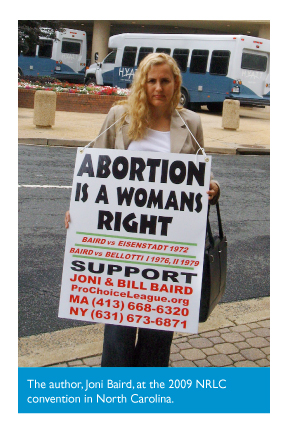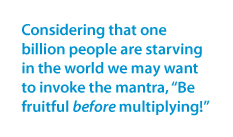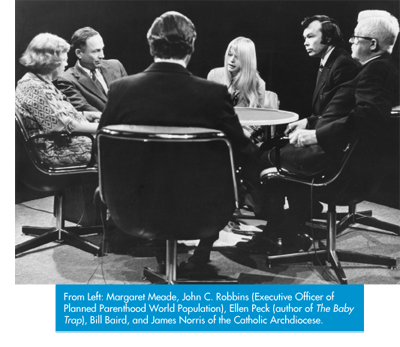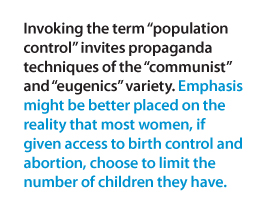An “Eco” Systems Approach: Reproductive Rights Go Green
Earth’s human inhabitants, now at 6.8 billion, are predicted to number 9.1 billion by 2050—a figure that stands to tip the global-warming scale past the point of no return. We must consider the effect that the availability of birth control—and yes, even abortion—will have on ameliorating this trend, as scientists agree that development and implementation of green technologies aren’t enough.
With nearly 79 million newcomers on our planet each year it would behoove us to apply a systems approach in order to curb overpopulation, which threatens our ecosystem and, consequently, humanity. This includes restoring the moral framework that reproductive healthcare was based on decades ago and that was used to change anti-birth control and anti-abortion laws.
In the 1960s and ’70s the issues of reproductive rights focused on women’s lives, their mental and physical health, and their desire to have and love children at the appropriate time of their choosing. Also emphasized was the need to end poverty, alleviate starvation, and protect the environment by balancing the population. By abandoning those roots, an educational void has been left where a moral conceptual model for reproductive rights once existed. (Gone are picket signs with photographs of starving, neglected children; instead, the public is more likely to see grisly pictures of aborted fetuses.)
The day after the 1973 Roe v. Wade decision, a Long Island Press story headlined “Fight Not Over” included a quote from Bill Baird (whose 1972 U.S. Supreme Court victory in Eisenstadt v. Baird legalized birth control nationally). In it Baird warned that despite Roe v. Wade, the Catholic Church and other abortion foes would continue fighting hard against the issue. Conversely, in a 1989 New York Times article, former Planned Parenthood New York City Executive Director Alfred Moran ruminated, “Most of us in the pro-choice community put our feet up and said, ‘That settles it.’ We believed that a chapter in history had been closed and we began to go on to other things.” Bill was able to predict the religious-right tsunami against a woman’s right to choose because he began monitoring their publications in the early 1960s and has attended nearly every National Right to Life Committee (NRLC) annual convention since the first in 1973.
 I attended my ninth NRLC convention in late June in North Carolina. Our daily peaceful protests were well covered by media, which helped to neutralize the group’s anti-abortion propaganda. As we attended workshops in order to learn more about their upcoming strategies, attendees approached us like unwanted computer pop-ups. One woman said, “I thought you’d be six feet under by now, Bill.” Another, dressed like a conservative Mormon wife, sang “Happy Birthday” (Bill turned seventy-seven during the convention) and ended it with a predictable, “aren’t you glad your mother didn’t abort you?” (I got off easy only having to endure scoffs and eye rolling at the sight of my “Trees are for hugging” t-shirt.)
I attended my ninth NRLC convention in late June in North Carolina. Our daily peaceful protests were well covered by media, which helped to neutralize the group’s anti-abortion propaganda. As we attended workshops in order to learn more about their upcoming strategies, attendees approached us like unwanted computer pop-ups. One woman said, “I thought you’d be six feet under by now, Bill.” Another, dressed like a conservative Mormon wife, sang “Happy Birthday” (Bill turned seventy-seven during the convention) and ended it with a predictable, “aren’t you glad your mother didn’t abort you?” (I got off easy only having to endure scoffs and eye rolling at the sight of my “Trees are for hugging” t-shirt.)
NRLC supporters see no connection between overpopulation and global warming. They don’t even see a connection between their vehement opposition to China and its reproductive policies and the fact that NRLC’s white plastic convention bracelets were stamped “Made in China.” Nor do they draw a connection between reducing abortions by way of birth control, stating that NRLC takes no official position on it. However, unofficially, every person we’ve spoken to at the conventions is completely opposed to encouraging the use of birth control. The only methods acceptable are abstinence or the rhythm method (which Bill calls “Vatican roulette”). “As long as right-to-life refuses to support better access to contraception,” warns Nancy Keenan, president of NARAL Pro-Choice America, “they will continue to be outside the mainstream of this country.” The same June 20, 2009, Charlotte Observer article in which Keenan was quoted also pointed out, however, that a recent Pew poll found support for legalized abortion was declining.
Anti-abortionists’ unwillingness to advocate for other forms of family planning—namely oral contraceptives, including the Plan B emergency contraceptive—is myopic to say the least and ignores the plight of women across the globe. A June 2009 report from Population Action International estimates that more than 200 million women in the developing world are denied birth control. That results in 52 million yearly unintended pregnancies, 140,000 pregnancy related deaths, 505,000 orphans, and 22 million abortions, according to the report.
 For too long, whenever progressive leaders try to find ethical, rational solutions to such devastating circumstances, they face a firing squad. The Population Research Institute (a group that attacks overpopulation as a myth) reported thusly on House Speaker Nancy Pelosi’s February 18 visit with Pope Benedict XVI: “Here in one chair is the Holy Father gently instructing his daughter about the sanctity of Life and her obligations as a Catholic legislator to defend it. And here in the other is Pelosi blathering on about Global Warming. Someone ought to remind Nancy that whatever the truth about Global Warming it is awfully hot in hell.”
For too long, whenever progressive leaders try to find ethical, rational solutions to such devastating circumstances, they face a firing squad. The Population Research Institute (a group that attacks overpopulation as a myth) reported thusly on House Speaker Nancy Pelosi’s February 18 visit with Pope Benedict XVI: “Here in one chair is the Holy Father gently instructing his daughter about the sanctity of Life and her obligations as a Catholic legislator to defend it. And here in the other is Pelosi blathering on about Global Warming. Someone ought to remind Nancy that whatever the truth about Global Warming it is awfully hot in hell.”
Despite such bellicose reactions (not to mention the penchant for incorrect capitalization), meeting with members of the opposition can be beneficial. Since 1999 the Pro Choice League (which I co-direct with my husband, Bill Baird) has met with members of Priests for Life with whom we’ve issued a joint statement for peace. The agreement discourages hate speech and encourages respectful dialogue in order to reduce potential violence. Over three decades ago, Bill met with Cardinal James Hickey (then a bishop) who issued a similar call for peace after an Ohio abortion clinic was firebombed. (One year later Bill’s clinic was firebombed with fifty people inside.)
Unfortunately too many church leaders have chosen to foment the debate. At the general assembly of the U.S. Conference of Catholic Bishops last November, Bishop Robert J. Hermann declared: “I think any bishop here would consider it a privilege to die tomorrow to bring about the end of abortion.” In his keynote speech before the Rochester, New York, chapter of the National Organization for Women on January 22, 2009, Bill labeled those remarks a “war cry” that could lead to violence and likened them to those expressed by suicide bombers who would die for Allah. Four months later, on May 31, abortion provider George Tiller, MD, was murdered in the presence of his wife and other congregants at their Lutheran Church.
 NRLC President Dr. Wanda Franz has called abortion “serial killing for profit,” and at the 2004 convention actor Ben Stein (co-writer and star of the anti-science film Expelled: No Intelligence Allowed) unleashed one of the worst invectives against abortion ever. He proclaimed that the NRLC was fighting the “worst holocaust in the history of modern man,” inveighing that, “these mass murderers call themselves doctors, and politicians, and, sadly, mothers.” According to Stein, such individuals are genetically defective, “sick, angry people.” Hammering his point home he accused those who support reproductive freedom of being “…genuinely, homicidally in a rage like the great murderers of history—like Himmler or Hitler or Stalin or Goebbels.” Working his audience into a frenzy, Stein then shouted, “I don’t want to help them out by psychoanalyzing them, I just want to stop them before they kill again! Stop NARAL—which to me is awfully close to ‘Nazi’—stop the sick SOBs who dare call themselves doctors and who make their living and buy their Mercedes and their BMWs with the lives of innocent children!” I walked out when Stein, after pressing the need to work within the law, referred to those who murder abortion providers and concluded, “I parenthetically understand those who don’t want to fight it within the law.”
NRLC President Dr. Wanda Franz has called abortion “serial killing for profit,” and at the 2004 convention actor Ben Stein (co-writer and star of the anti-science film Expelled: No Intelligence Allowed) unleashed one of the worst invectives against abortion ever. He proclaimed that the NRLC was fighting the “worst holocaust in the history of modern man,” inveighing that, “these mass murderers call themselves doctors, and politicians, and, sadly, mothers.” According to Stein, such individuals are genetically defective, “sick, angry people.” Hammering his point home he accused those who support reproductive freedom of being “…genuinely, homicidally in a rage like the great murderers of history—like Himmler or Hitler or Stalin or Goebbels.” Working his audience into a frenzy, Stein then shouted, “I don’t want to help them out by psychoanalyzing them, I just want to stop them before they kill again! Stop NARAL—which to me is awfully close to ‘Nazi’—stop the sick SOBs who dare call themselves doctors and who make their living and buy their Mercedes and their BMWs with the lives of innocent children!” I walked out when Stein, after pressing the need to work within the law, referred to those who murder abortion providers and concluded, “I parenthetically understand those who don’t want to fight it within the law.”
Such propaganda has been employed for decades by anti-abortion leaders because they can’t attain their goals via arguments based on scientific, legal, or ethical grounds. Instead, “the primary cultural opposition to sensible birth control is rooted in religion,” notes American Humanist Association President David Niose. “Indeed, it is in secular societies, where religion holds the least sway, that mature approaches to family planning and sexuality in general have resulted in the lowest population growth,” he concludes.
The best defense in supporting reproductive rights is to create a good offense, namely, to tie them to the environmental movement. A wonderful model that can be expanded to include global warming comes from a statement by the International Humanist Ethical Union. It reads,
IHEU views with alarm the continuing increase in world population and recognizes this as one of the most urgent problems facing mankind. Malnutrition, starvation, poverty, lack of medical and educational services, pollution of the environment, underdevelopment, conflict, and war are already and will continue to be aggravated by excessive numbers of people. The IHEU, in working to build a world where each child born should have an environment in which it may grow to reach its full human potential and realizing the impossibility of this if present population trends continue, calls on international agencies, national governments, humanists organizations, and people of goodwill everywhere to cooperate in order to limit population growth.
In 1964 Bill coined the phrase “To be wanted and loved is every child’s birthright.” On April 6, 1967, during his speech before 2,500 Boston University students in order to challenge the law that resulted in Eisenstadt v. Baird, he talked about “people pollution” and overpopulation. He accurately predicted that the world’s population would double in forty years to six billion. And then in 1968 he constructed a gigantic “population bomb” out of plywood. His first attempt to unveil the huge float (complete with fuse) met with disaster. On his way to a news conference the giant sphere dislodged from its trailer and bounced across New York’s Long Island Expressway. The next day news headlines read, “World Falls on Pill Crusader” and “Population Explosion.” Never one to give up, Bill set off on a two-hundred-mile march from New York to Boston, population prop in tow.
On March 21, 1972, the day before the Eisenstadt v. Baird decision, New York’s WOR-TV, in cooperation with the United Nations, presented Earth Day ’72. WOR’s news release stated, “For the first time in the history of the world, representatives from 130 countries will meet in June 1972 to discuss solutions to problems of the environment.” Bill, along with Dr. Margaret Meade and others were featured on the program. At that time, Maurice F. Strong, Secretary General of the UN Conference on the Human Environment, prophetically said, “The environmental crisis has made us aware that the future life and wellbeing of man depends upon the preservation of a healthy equilibrium in the natural systems which include the essential ingredients for his life; water, air, soil, plant and animal life. These systems are fragile, finite, and interdependent as part of a complex unitary system of interacting relationships which embrace the entire globe.”
Too little has been done since then to preserve our planet but it isn’t too late if we take a quantum leap forward in our thinking. Inevitably, foot-draggers who insist on ignoring scientific evidence will mock us.
Ominous atmospheric changes have caused some to lament that we are lemmings doomed to extinction. Fundamentalists await the outcome of what surely are the “End Times.” A February 2009 Washington Post article even reported on the new trend of “ecomigration” whereby those who fear climate catastrophes such as hurricanes and rising seas relocate to entirely different countries.
 However there are a growing number of optimists who refuse to listen to Mother Earth sing her swan song. They believe that humanity can be cattle prodded towards a new vision, a multi-pronged, holistic approach that examines the subsystems involved in maintaining a balanced eco-system, and takes into account the impact of government (especially policy-making), education, religion, psychology, technology, healthcare, and so forth. Reproductive rights must be part of the equation.
However there are a growing number of optimists who refuse to listen to Mother Earth sing her swan song. They believe that humanity can be cattle prodded towards a new vision, a multi-pronged, holistic approach that examines the subsystems involved in maintaining a balanced eco-system, and takes into account the impact of government (especially policy-making), education, religion, psychology, technology, healthcare, and so forth. Reproductive rights must be part of the equation.
While President Obama has kept a tight lid on his forthcoming reproductive healthcare policy plans, the Waxman-Markey energy bill that seeks in part to cap emissions recently (and barely) passed in the House. Yes votes totaled 219 and the 212 no votes were overwhelmingly cast by Republicans. Before the tally, Rep. Paul Broun (R-GA) blamed the scientific community for what he called the climate change “hoax,” prompting Republican applause. According to Gallup.com, 66 percent of Republicans think global warming is exaggerated in contrast to 20 percent of Democrats.
This bill must now pass the Senate. How important is it? Washington Monthly stated, “Mostclimatologists believe that if moderately ambitious targets on the order of Waxman’s bill are not met by 2020 we will be helpless to stop warming trends before they hit a tipping point, beyond which there is nothing we can do.”
To those who criticized the bill, Democratic strategist Bob Beckel said in the July 9 issue of USA Today that many conservatives were buying into the Flat Earth Society. “This ship has sailed,” Beckel said, “and by many estimates, it’ll be sailing on higher seas at the rate we’re going.” He also admonished Republicans for “scrapping the bottom of the barrel if you have to criticize this president for using energy-efficient light bulbs.”
While Republicans try to induce fear tactics against the Waxman-Markey cap-and-trade bill, calling it a “job-killer,” clean-energy stocks are up. Thom Wright, owner of BASK Power in Massachusetts is an energy consultant and installer of solar, geothermal, wind, and other green technology systems. Wright says, “The key to energy savings is education. From home builders and designers to equipment installers and contractors to homeowners, each link in the chain needs to be thinking environmentally.” He’s also happy that “our governments are providing readily available funding for these changes.”
The G-8 Climate Scorecards, compiled by the World Wildlife Fund, ranked the United States and Canada last on curbing global warming, conceding that “there has been more action in the U.S. in the last four months than in the last three decades—a trend that will hopefully continue.”
 The celerity with which the Obama administration has taken action on the environment is encouraging but we must take action on a variety of levels, especially reducing worldwide population, in order to avert disaster. Still, some feel that invoking the term “population control” invites propaganda techniques of the “communist” and “eugenics” variety. Emphasis might be better placed on the reality that most women, if given access to birth control and abortion, choose to limit the number of children they have. It is a fact that the more educated a woman, the fewer children she will bear. They are too often shamed for wanting to secure their economic footing before having children. Considering that one billion people are starving in the world we may want to invoke the mantra, “Be fruitful before multiplying!”
The celerity with which the Obama administration has taken action on the environment is encouraging but we must take action on a variety of levels, especially reducing worldwide population, in order to avert disaster. Still, some feel that invoking the term “population control” invites propaganda techniques of the “communist” and “eugenics” variety. Emphasis might be better placed on the reality that most women, if given access to birth control and abortion, choose to limit the number of children they have. It is a fact that the more educated a woman, the fewer children she will bear. They are too often shamed for wanting to secure their economic footing before having children. Considering that one billion people are starving in the world we may want to invoke the mantra, “Be fruitful before multiplying!”
Educating new generations about what women faced before abortion and birth control were legal is imperative. When we speak at college campuses, students gasp in horror when Bill shows them his perennial birth control and abortion board. On it are crude devices women used (and in some cases still do) to self-abort, such as douching bags filled with Lysol, bleach, or turpentine, coat hangers, and other objects. Explaining that women were routinely robbed and raped by quack abortionists draws equal moral outrage.
A popular yearly National Right to Life Committee workshop called, “We are the Sheep, Where are the Shepherds?” echoes a worn-out, hierarchal paradigm. Fortunately, we who are self-directed don’t need to wait around for someone outside ourselves to tell us what to do. We have the powerful tools of science, education, and compassion to help us. And to those who might accuse us of acting as though environmentalism is a new religion, I say “Hallelujah!”
